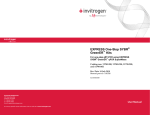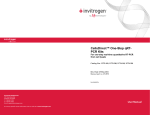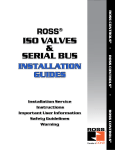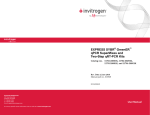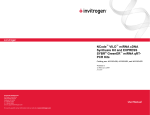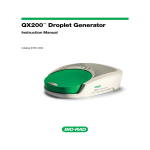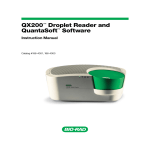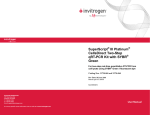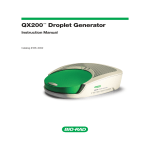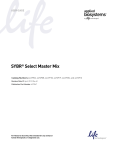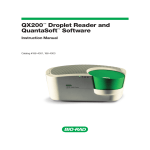Download EXPRESS One-Step SuperScript
Transcript
EXPRESS One-Step SuperScript® qRT-PCR Kits For one-step qRT-PCR with SuperScript® Reverse Transcriptase Catalog nos. 11781-200, 11781-01K, 11791-200, and 11791-01K Rev. Date: 28 June 2010 Manual part no. A10327 MAN0000689 Corporate Headquarters 5791 Van Allen Way Carlsbad, CA 92008 T: 1 760 603 7200 F: 1 760 602 6500 E: [email protected] For country-specific contact information visit our web site at www.invitrogen.com User Manual ii Table of Contents Kit Contents and Storage .........................................................................iv Overview..................................................................................................... 1 Instrument Compatibility ......................................................................... 4 Methods ........................................................................................ 5 General Guidelines and Parameters........................................................ 5 Template RNA ........................................................................................... 7 Universal Kits—Guidelines and Protocols............................................. 9 Kits with Premixed ROX—Guidelines and Protocols......................... 12 Troubleshooting ....................................................................................... 15 Appendix .................................................................................... 17 Additional Products ................................................................................ 17 Technical Support .................................................................................... 18 Purchaser Notification ............................................................................ 20 References ................................................................................................. 22 iii Kit Contents and Storage Kit Components and Storage EXPRESS One-Step SuperScript® qRT-PCR Kits are shipped on dry ice. The components in each kit are listed below. Store all components at –20°C for long-term storage. SuperMixes may be stored at 4–8°C for up to one month. EXPRESS One-Step SuperScript® qRT-PCR Universal EXPRESS qPCR SuperMix Universal ROX Reference Dye 11781-200 11781-01K 5 ml 5 × 5 ml 500 μl 5 × 500 μl ® 1 ml 5 × 1 ml EXPRESS One-Step SuperScript® qRT-PCR with Premixed ROX 11791-200 11791-01K EXPRESS qPCR SuperMix with Premixed ROX 5 ml 5 × 5 ml EXPRESS SuperScript® Mix for One-Step qPCR 1 ml 5 × 1 ml EXPRESS SuperScript Mix for One-Step qPCR iv Overview Introduction EXPRESS One-Step SuperScript® qRT-PCR Kits provide components for one-step reverse transcription and quantitative PCR (qRT-PCR) in a convenient format that is compatible with both rapid and standard qPCR cycling conditions. Both cDNA synthesis and PCR are performed in a single tube using gene-specific primers and either total RNA or mRNA. These one-step qRT-PCR kits have been formulated for use with fluorogenic probe-based technology (e.g., TaqMan® probes) or fluorogenic primers (e.g., LUX™ Primers). The RT mix includes SuperScript® III Reverse Transcriptase and RNaseOUT™ Recombinant Ribonuclease Inhibitor in an optimized formulation. All EXPRESS qPCR SuperMixes include Platinum® Taq DNA polymerase, MgCl2, dNTPs (with dUTP instead of dTTP), uracil DNA glycosylase (UDG), and stabilizers. Note that this unique one-step formulation includes a special heat-labile form of UDG in the SuperMix to help prevent reamplification of carryover PCR products between reactions. • SuperMix with Premixed ROX: The qPCR SuperMix with premixed ROX includes ROX Reference Dye at a final concentration of 500 nM to normalize the fluorescent signal on instruments that are compatible with this option. • Universal SuperMix: The Universal SuperMix includes ROX as a separate component for instruments that use ROX at a different concentration or do not require ROX. Continued on next page 1 Overview, continued Advantages of the Kits SuperScript® III Reverse Transcriptase • This highly robust one-step formulation provides optimal convenience and sensitivity in qRT-PCR, with sensitive detection and a broad quantification range • SuperScript® III Reverse Transcriptase has been engineered for reduced RNase H activity and increased thermal stability, resulting in higher yields of cDNA • Platinum® Taq DNA Polymerase provides an automatic “hot start” in PCR for increased sensitivity, specificity, and yield, and has a short activation time for the rapid cycling of fast qPCR instruments • A special heat-labile form of UDG in the SuperMix prevents amplification of carryover PCR products between one-step reactions • The same SuperMix is also used in non-one-step EXPRESS qPCR kits (available separately), for maximum flexibility SuperScript® III Reverse Transcriptase is a version of M-MLV RT that has been engineered to reduce RNase H activity and provide increased thermal stability for higher yields of cDNA (Kotewicz et al., 1985). The enzyme in this RT mix formulation can synthesize cDNA at a temperature range of 50–60°C. Because SuperScript® III RT is not significantly inhibited by ribosomal and transfer RNA, it can be used to synthesize cDNA from total RNA. RNaseOUT™ Ribonuclease Inhibitor is included in the SuperScript® mix to safeguard against degradation of target RNA due to ribonuclease contamination. Platinum® Taq DNA Polymerase Platinum® Taq DNA Polymerase is recombinant Taq DNA polymerase complexed with proprietary antibodies that block polymerase activity at ambient temperatures (Chou et al., 1992; Sharkey et al., 1994). Activity is restored after the initial denaturation step in PCR cycling, providing an automatic hot start in qPCR for increased sensitivity, specificity, and yield. Continued on next page 2 Overview, continued Uracil DNA Glycosylase (UDG) UDG and dUTP in the qPCR SuperMix prevent the reamplification of carryover PCR products between reactions (Lindahl et al., 1977; Longo et al., 1990). dUTP ensures that any amplified DNA will contain uracil, while UDG removes uracil residues from single- or doublestranded DNA. The UDG used in the kit is a heat-labile form of the enzyme that destroys any contaminating dU-containing product from previous reactions prior to cDNA synthesis. UDG is inactivated at temperatures of 50°C or higher, thereby allowing cDNA synthesis from genuine target sequences. ROX Reference Dye ROX Reference Dye is either premixed in the SuperMix or included as a separate component to normalize the fluorescent signal between reactions for instruments that are compatible with this option. ROX can adjust for non-PCRrelated fluctuations in fluorescence between reactions, and provides a stable baseline in multiplex reactions. Additional Materials Required The following items are supplied by the user: • Template RNA • Gene-specific fluorescent primers or primer/probe combinations • DEPC-treated water • Microcentrifuge • Thermal cycler • Optional: Normalization dye for instruments that do not use ROX • PCR tubes/plates 3 Instrument Compatibility Universal Kits Kits with Premixed ROX 4 EXPRESS One-Step SuperScript® qRT-PCR Universal includes ROX Reference Dye as a separate tube, and can be used with a wide range of real-time instruments including the following: • Applied Biosystems: 7900HT, 7300, 7500, StepOne™, StepOnePlus™, GeneAmp® 5700, and PRISM® 7000 and 7700 • Bio-Rad/MJ Research: iCycler® iQ, iQ5, and MyiQ™; DNA Engine Opticon® and Opticon® 2; and Chromo4™ Real-Time Detector • Cepheid: Smart Cycler® • Corbett Research: Rotor-Gene™ 3000 • Eppendorf: Mastercycler® ep realplex • Roche: LightCycler® 480 • Stratagene: Mx3000P™, Mx3005P™, and Mx4000® EXPRESS One-Step SuperScript® qRT-PCR with Premixed ROX can be used with real-time instruments that are compatible with ROX Reference Dye at a final concentration of 500 nM. These include the following Applied Biosystems instruments: • 7900HT • 7300 • StepOne™ • StepOnePlus™ • GeneAmp® 5700 • PRISM® 7000 and 7700 Methods General Guidelines and Parameters Reaction Setup and Conditions Fluorescent Probe-Based Technologies • Starting material can be total RNA or mRNA. • These kits use a two-step cycling protocol, with a denaturation step at 95°C and an annealing/extension step at 60°C. • Keep all components, reaction mixes and samples on ice to prevent premature cDNA synthesis. • Reaction volumes can be scaled from 5 μl to 100 μl, depending on the instrument. • For most templates, efficient cDNA synthesis can be accomplished in a 5-minute incubation at 50°C. For problematic templates, or to increase the specificity of cDNA priming, increase the cDNA synthesis temperature up to 60°C. • For instrument-specific guidelines, see the section for each type of kit. Fluorescent probe-based technologies, such as TaqMan® Gene Expression Assays, use two gene-specific primers with a fluorescent labeled probe that is cleaved due to the 5’ to 3’ exo-nuclease activity of Taq DNA polymerase, thereby emitting a signal during PCR amplification. These probeprimer combinations may be packaged as predesigned gene-specific assays or custom designed for a target of interest. Consult the documentation provided with your fluorescent probe product to determine the optimal concentration in qRT-PCR. EXPRESS One-Step SuperScript® qRT-PCR Kits were developed using TaqMan® Gene Expression Assays provided at a 20X concentration as well as custom-designed mixtures in which the final primer concentration was 500 nM each and the final probe concentration was 200 nM. Continued on next page 5 General Guidelines and Parameters, continued Fluorescent Primers LUX™ Primers, available separately from Invitrogen, are a fluorescent primer-based detection technology consisting of one gene-specific primer labeled with a single fluorophore and a corresponding unlabeled primer. The labeled primer is designed with the fluorophore near the 3´ end in a hairpin structure that effectively quenches fluorescence prior to PCR, making a separate quenching moiety unnecessary. When the primer becomes incorporated into doublestranded PCR product, the fluorophore is de-quenched, resulting in a significant increase in fluorescent signal. LUX™ Primers are available in pre-designed formats (www.invitrogen.com/lux) or can be designed for specific targets using the D-LUX™ Designer (www.invitrogen.com/dluxdesigner). Unlike fluorescent probe-based technologies, they are compatible with melting curve analysis. A final concentration of 200 nM per primer is effective for most reactions. Doubling the amount of reverse primer (to 400 nM) may improve the performance of certain reactions. Optimal results may require a primer titration between 100 and 500 nM. Melting Curve Analysis Melting curve analysis may be used with fluorescent primers to identify the presence of primer dimers and analyze the specificity of the reaction. Note that melting curve analysis cannot be used with fluorescent probe-based technologies. Program your instrument for melting curve analysis using the instructions provided with your specific instrument. 6 Template RNA Input RNA Starting material can range from 1 pg to 1 μg of purified total RNA. If you are starting with isolated mRNA, the amount of template may be as low as 0.5 pg. RNA should be free of RNase contamination and aseptic conditions should be maintained. RNA may be treated with amplificationgrade DNase I (see page 17) to remove any contaminating genomic DNA. To isolate total RNA, we recommend the PureLink™ Microto-Midi™ Total RNA Purification System, TRIzol® Reagent, or the PureLink™ 96 Total RNA Purification Kit for highthroughput applications (see page 17 for ordering information). General Handling of RNA When working with RNA: • Use disposable, individually wrapped, sterile plasticware. • Use aerosol resistant pipette tips for all procedures. • Use only sterile, new pipette tips and microcentrifuge tubes. • Wear latex gloves while handling reagents and RNA samples to prevent RNase contamination from the surface of the skin. • Use proper microbiological aseptic technique when working with RNA. • Dedicate a separate set of pipettes, buffers, and enzymes for RNA work. • Use RNase-free microcentrifuge tubes. If it is necessary to decontaminate untreated tubes, soak the tubes overnight in a 0.01% (v/v) aqueous solution of diethylpyrocarbonate (DEPC), rinse the tubes with sterile distilled water, and autoclave the tubes. You can use RNase Away™ Reagent, a non-toxic solution available from Invitrogen, to remove RNase contamination from surfaces. For further information on controlling RNase contamination, see (Ausubel et al., 1994; Sambrook et al., 1989). Continued on next page 7 Template RNA, continued Determining Total RNA Yield Total RNA can be quantitated using the Quant-iT™ RNA Assay Kit or UV absorbance at 260 nm. Quant-iT™ RNA Assay Kit The Quant-iT™ RNA Assay Kit provides a rapid, sensitive, and specific method for RNA quantitation with minimal interference from DNA, protein, or other common contaminants that affect UV absorbance readings. The kit contains a quantitation reagent and pre-diluted standards for a standard curve. The assay is performed in a microtiter plate and can be read using a standard fluorescent microplate reader. UV Absorbance 1. Dilute an aliquot of the total RNA sample in 10 mM Tris-HCl, pH 7.5. Mix well. Transfer to a cuvette (1-cm path length). Note: The RNA must be in a neutral pH buffer to accurately measure the UV absorbance. 2. Determine the OD260 of the solution using a spectrophotometer blanked against 10 mM Tris-HCl, pH 7.5. Calculate the amount of total RNA using the following formula: Total RNA (μg) = OD260 × [40 μg/(1 OD260 × 1 ml)] × dilution factor × total sample volume (ml) Example: Total RNA was eluted in water in a total volume of 150 μl. A 40-μl aliquot of the eluate was diluted to 500 μl in 10 mM Tris-HCl, pH 7.5. An OD260 of 0.188 was obtained. The amount of RNA in the sample is: Total RNA (μg) = 0.188 × [40 μg/(1 OD260 × 1 ml)] × 12.5 × 0.15 = 14.1 μg Determining Total RNA Quality 8 Total RNA quality can be analyzed using a bioanalyzer such as the Agilent 2100 bioanalyzer with an RNA LabChip®. Alternatively, total RNA can be analyzed by agarose gel electrophoresis. RNA isolated using the PureLink™ kits or TRIzol® Reagent typically has a 28S-to-18S band ratio of >1.5. RNA is judged to be intact if discreet 28S and 18S ribosomal RNA bands are observed. Universal Kits—Guidelines and Protocols Introduction This section provides a protocol and guidelines for one-step qPCR using EXPRESS One-Step SuperScript® qRT-PCR Universal. Additional Materials Required The following items are supplied by the user: ROX Reference Dye Concentration • DEPC-treated water • Fluorescent primers/probes (see pages 6–5 for information) • Microcentrifuge • Thermal cycler (see page 4 for information on compatible thermal cyclers) • PCR tubes/plates ROX Reference Dye is supplied as a separate tube in the Universal Kits. ROX is recommended for fluorescence normalization on Applied Biosystems® instruments, and is optional for Stratagene’s Mx3000P™, Mx3005P™, and Mx4000®. It is not required on other instruments. ROX is composed of a glycine conjugate of 5-carboxy-X-rhodamine, succinimidyl ester and is supplied at a concentration of 25 μM. Use the following table to determine the amount of 25-μM ROX to use with a particular instrument: Instrument AB 7300, 7900HT, StepOne™, StepOnePlus™, and PRISM® 7000 and 7700 AB 7500, Stratagene Mx3000P™, Mx3005P™, and Mx4000® Amount of ROX per 20-μl reaction Effective Fold Concentration of 25-μM ROX Final ROX Concentration 0.4 μl 50X 500 nM 0.04 μl 500X 50 nM Continued on next page 9 Universal Kits—Guidelines and Protocols, continued Cycling Programs — Universal Kits The following one-step cycling programs have been developed as a general starting point when using EXPRESS One-Step SuperScript® qRT-PCR Universal. Program your real-time instrument to perform cDNA synthesis at or above 50°C, immediately followed by PCR amplification as shown below. The fast cycling program is designed for the AB 7500 in Fast mode. Note: This mix is highly robust and can be used with a wide range of cycling programs on different instruments. If you have an alternative program that you want to use, you should test it with this mix. Note that your protocol must include an initial ≥50°C incubation step for UDG inactivation and cDNA synthesis. Fast Cycling Program (for AB 7500 in Fast Mode) 50°C for 15-minute hold (cDNA synthesis) 95°C for 20-second hold 40 cycles of: 95°C for 3 seconds 60°C for 30 seconds Optional: Melting curve analysis (fluorescent primers only): 60°C– 95°C (refer to instrument manual for specific programming) Standard Cycling Program 50°C for 15-minute hold (cDNA synthesis) 95°C for 2-minute hold 40 cycles of: 95°C for 15 seconds 60°C for 1 minute Optional: Melting curve analysis (fluorescent primers only): 60°C– 95°C (refer to instrument manual for specific programming) Continued on next page 10 Universal Kits—Guidelines and Protocols, continued One-Step qPCR — Universal Mix Use the protocol below as a general starting point. Scale the reaction volume as needed for your real-time instrument. ROX is recommended for Applied Biosystems® instruments and optional for Stratagene® instruments (see page 9). 1. Set up reactions on ice. A standard 20-μl reaction size is provided; component volumes can be scaled as desired. Always prepare a master mix of common components for multiple reactions. EXPRESS SuperScript® qPCR SuperMix Universal Fluorescent primer/probe mix (conc. and volume 20-μl rxn 10 μl specified by manufacturer) X μl ROX Reference Dye (25 μM) 0.4 μl/0.04* μl EXPRESS SuperScript® Mix for One-Step qPCR 2 μl 5 μl Template RNA (e.g., 1 pg–1 μg total RNA) DEPC-treated water to 20 μl *See the table on page 9 for the amount/concentration of ROX to use for your specific instrument. 2. Prepare control reactions as follows: No-RT controls: To test for genomic DNA contamination of the RNA sample, do not add the EXPRESS SuperScript® Mix. No-template controls: To test for genomic DNA contamination of the enzyme/primer mixes, do not add template RNA. 3. Cap or seal each PCR tube/plate, and gently mix. Make sure that all components are at the bottom of the tube/plate; centrifuge briefly if needed. 4. Place reactions in a real-time instrument programmed as described on the previous page. Collect data and analyze results. 5. Optional: The specificity of the PCR products can be checked by agarose gel electrophoresis. 11 Kits with Premixed ROX—Guidelines and Protocols Introduction This section provides a protocol and guidelines for one-step qRT-PCR using EXPRESS One-Step SuperScript® qRT-PCR Universal. Additional Materials Required The following items are supplied by the user: Premixed ROX Concentration • DEPC-treated water • Fluorescent primers/probes (see pages 6–5 for information) • Microcentrifuge • Thermal cycler (see page 4 for information on compatible thermal cyclers) • PCR tubes/plates ROX Reference Dye is included in the SuperMix at a final concentration of 500 nM, which is compatible with Applied Biosystems® 7900HT, 7300, StepOne™, StepOnePlus™, GeneAmp® 5700, and PRISM® 7000 and 7700. Continued on next page 12 Kits with Premixed ROX—Guidelines and Protocols, continued Cycling Programs — Kits with Premixed ROX The following one-step cycling programs have been developed as a general starting point when using EXPRESS One-Step SuperScript® qRT-PCR Universal. Program your real-time instrument to perform cDNA synthesis at or above 50°C, immediately followed by PCR amplification as shown below. The fast cycling program is designed for the AB 7900HT and StepOne™. Note: This mix is highly robust and can be used with a wide range of cycling programs on different instruments. If you have an alternative program that you want to use, you should test it with this mix. Note that your protocol must include an initial ≥50°C incubation step for UDG inactivation and cDNA synthesis. Fast Cycling Program (for AB 7900HT and StepOne™) 50°C for 15 minutes (cDNA synthesis) 95°C for 20 seconds 40 cycles of: 95°C for 1 second 60°C for 20 seconds Optional: Melting curve analysis (fluorescent primers only): 60°C– 95°C (refer to instrument manual for specific programming) Standard Cycling Program 50°C for 15 minutes (cDNA synthesis) 95°C for 2 minutes 40 cycles of: 95°C for 15 seconds 60°C for 1 minute Optional: Melting curve analysis (fluorescent primers only): 60°C– 95°C (refer to instrument manual for specific programming) Continued on next page 13 Kits with Premixed ROX—Guidelines and Protocols, continued One-Step qPCR — Kits with Premixed ROX Use the protocol below as a general starting point for onestep qRT-PCR. Scale the reaction volume as needed for your real-time instrument. 1. Set up reactions on ice. A standard 20-μl reaction size is provided; component volumes can be scaled as desired. Always prepare a master mix of common components for multiple reactions. EXPRESS qPCR SuperMix with Premixed ROX Fluorescent primer/probe mix (conc. and volume specified by manufacturer) EXPRESS SuperScript® Mix for One-Step qPCR Template RNA (e.g., 1 pg–1 μg total RNA) DEPC-treated water 2. 20-μl rxn 10 μl X μl 2 μl 5 μl to 20 μl Prepare control reactions as follows: No-RT controls: To test for genomic DNA contamination of the RNA sample, do not add the EXPRESS SuperScript® Mix. No-template controls: To test for genomic DNA contamination of the enzyme/primer mixes, do not add template RNA. 14 3. Cap or seal each PCR tube/plate, and gently mix. Make sure that all components are at the bottom of the tube/plate; centrifuge briefly if needed. 4. Place reactions in a real-time instrument programmed as described on the previous page. Collect data and analyze results. 5. Optional: The specificity of the PCR products can be checked by agarose gel electrophoresis. Troubleshooting Problem Cause Solution No PCR product is evident in the qPCR graph or on a gel RNA has been damaged/degraded Confirm RNA degradation by bioanalyzer or running on a gel, and replace RNA if necessary. RNase contamination Maintain aseptic conditions. cDNA synthesis temperature too high, low priming efficiency SuperScript® III in this formulation typically operates in a temperature range of 50°C–60°C. Primers are blocked by secondary structure Raise the incubation temperature and/or redesign primers/probes. PCR product is qPCR instrument evident on a gel, but settings are not in the qPCR incorrect graph Confirm that you are using the correct instrument settings (dye selection, reference dye, filters, and acquisition points). Product detected at higher than expected cycle number Inefficient cDNA synthesis Adjust cDNA synthesis temperature and/or primer design. RT inhibitors are present in RNA Remove inhibitors in the RNA preparation by an additional 70% ethanol wash. RNA has been damaged/degraded Confirm RNA degradation by Bioanalyzer or running on a gel, and replace if necessary. RNase contamination Maintain aseptic conditions. Inefficient PCR amplification Optimize PCR conditions by adjusting annealing temperature and/or redesigning the primers. Not enough template RNA Increase concentration of template RNA to 10 ng–1 μg total RNA. Too much sample added to reactions Decrease the concentration of template RNA. Higher than expected signal Continued on next page 15 Troubleshooting, continued Problem Cause Solution Signals are present in no-template controls, and/or multiple peaks are present in the melting curve graph Template or reagents are contaminated by nucleic acids (DNA, cDNA) Use melting curve analysis (fluorescent primers only) and/or run the PCR products on a gel after the reaction to identify contaminants. See the guidelines for avoiding contamination on page 7. Primer dimers or other primer/probe artifacts are present If you are using fluorescent primers, use melting curve analysis to identify primer dimers (melting curve analysis cannot be used with probes). We recommend using validated pre-designed primer/probe sets or design them using dedicated software programs or primer databases. Primer/probe contamination or truncated or degraded oligos can lead to artifacts. Check the purity by gel electrophoresis. 16 Appendix Additional Products Related products are available separately from Invitrogen. Ordering information is provided below. For more information, visit our website at www.invitrogen.com or contact Technical Service (page 17). Additional Products Product ® TaqMan Gene Expression Assays ™ LUX Fluorogenic Primers ™ RNase Away Reagent DNase I, Amplification Grade Quant-iT™ RNA Assay Kit TRIzol® Reagent PureLink™ 96 Total RNA Purification Kit Quantity Catalog no. visit www.invitrogen.com/taqman visit www.invitrogen.com/lux 250 ml 10328-011 100 units 18068-015 1 kit Q-33140 100 ml 200 ml 15596-026 15596-018 4 × 96-well plates 12173-011 17 Technical Support Web Resources Contact Us Visit the Invitrogen website at www.invitrogen.com for: • Technical resources, including manuals, vector maps and sequences, application notes, SDSs, FAQs, formulations, citations, handbooks, etc. • Complete technical support contact information • Access to the Invitrogen Online Catalog • Additional product information and special offers For more information or technical assistance, call, write, fax, or email. Additional international offices are listed on our website (www.invitrogen.com). Corporate Headquarters: 5791 Van Allen Way Carlsbad, CA 92008 USA Tel: 1 760 603 7200 Tel (Toll Free): 1 800 955 6288 Fax: 1 760 602 6500 E-mail: [email protected] Japanese Headquarters: LOOP-X Bldg. 6F 3-9-15, Kaigan Minato-ku, Tokyo 108-0022 Tel: 81 3 5730 6509 Fax: 81 3 5730 6519 E-mail: [email protected] European Headquarters: Inchinnan Business Park 3 Fountain Drive Paisley PA4 9RF, UK Tel: +44 (0) 141 814 6100 Tech Fax: +44 (0) 141 814 6117 E-mail: [email protected] SDS Safety Data Sheets (SDSs) are available on our website at www.invitrogen.com/sds. Certificate of Analysis The Certificate of Analysis provides detailed quality control and product qualification information for each product. Certificates of Analysis are available on our website. Go to www.invitrogen.com/support and search for the Certificate of Analysis by product lot number, which is printed on the box. Continued on next page 18 Technical Support, continued Limited Warranty Invitrogen (a part of Life Technologies Corporation) is committed to providing our customers with high-quality goods and services. Our goal is to ensure that every customer is 100% satisfied with our products and our service. If you should have any questions or concerns about an Invitrogen product or service, contact our Technical Support Representatives. All Invitrogen products are warranted to perform according to specifications stated on the certificate of analysis. The Company will replace, free of charge, any product that does not meet those specifications. This warranty limits the Company’s liability to only the price of the product. No warranty is granted for products beyond their listed expiration date. No warranty is applicable unless all product components are stored in accordance with instructions. The Company reserves the right to select the method(s) used to analyze a product unless the Company agrees to a specified method in writing prior to acceptance of the order. Invitrogen makes every effort to ensure the accuracy of its publications, but realizes that the occasional typographical or other error is inevitable. Therefore the Company makes no warranty of any kind regarding the contents of any publications or documentation. If you discover an error in any of our publications, report it to our Technical Support Representatives. Life Technologies Corporation shall have no responsibility or liability for any special, incidental, indirect or consequential loss or damage whatsoever. The above limited warranty is sole and exclusive. No other warranty is made, whether expressed or implied, including any warranty of merchantability or fitness for a particular purpose. 19 Purchaser Notification Limited Use Label License No. 14: Direct Inhibition by Anti-Polymerase Antibodies Licensed to Life Technologies Corporation, under U.S. Patent Nos. 5,338,671; 5,587,287; and foreign equivalents for use in research only. Limited Use Label License No. 274: 5´ Nuclease Process A license to perform the 5' nuclease process for research requires the use of a Licensed 5' Nuclease Kit (containing Licensed Probe), or the combination of an Authorized Core Kit plus Licensed Probe, or license rights that may be purchased from Applied Biosystems. This product is an Authorized Core Kit without Licensed Probe. Its purchase price includes a limited, non-transferable immunity from suit under U.S. Patents and corresponding patent claims outside the United States, owned by Roche Molecular Systems, Inc. or F. Hoffmann-La Roche Ltd (“Roche”), for using only this amount of the product in the practice of the 5' nuclease process solely for the purchaser's own internal research and development activities. This product is also an Authorized Core Kit for use with service sublicenses available from Applied Biosystems. This product conveys no rights under U.S. Patents Nos. 5,804,375, 6,214,979, 5,538,848, 5,723,591, 5,876,930, 6,030,787, or 6,258,569, or corresponding patent claims outside the United States, expressly, by implication, or by estoppel. No right under any other patent claims (such as apparatus or system claims) and no right to perform commercial services of any kind, including without limitation reporting the results of purchaser's activities for a fee or other commercial consideration, is hereby granted expressly, by implication, or by estoppel. This product is for research purposes only. Diagnostic uses require a separate license from Roche. Further information regarding the 5' nuclease licensing program may be obtained from the Director of Licensing, Applied Biosystems, 850 Lincoln Centre Drive, Foster City, California 94404, USA. Continued on next page 20 Purchaser Notification, continued Limited Use Label License No. 5: Invitrogen Technology The purchase of this product conveys to the buyer the nontransferable right to use the purchased amount of the product and components of the product in research conducted by the buyer (whether the buyer is an academic or for-profit entity). The buyer cannot sell or otherwise transfer (a) this product (b) its components or (c) materials made using this product or its components to a third party or otherwise use this product or its components or materials made using this product or its components for Commercial Purposes. The buyer may transfer information or materials made through the use of this product to a scientific collaborator, provided that such transfer is not for any Commercial Purpose, and that such collaborator agrees in writing (a) not to transfer such materials to any third party, and (b) to use such transferred materials and/or information solely for research and not for Commercial Purposes. Commercial Purposes means any activity by a party for consideration and may include, but is not limited to: (1) use of the product or its components in manufacturing; (2) use of the product or its components to provide a service, information, or data; (3) use of the product or its components for therapeutic, diagnostic or prophylactic purposes; or (4) resale of the product or its components, whether or not such product or its components are resold for use in research. For products that are subject to multiple limited use label licenses, the terms of the most restrictive limited use label license shall control. Life Technologies Corporation will not assert a claim against the buyer of infringement of patents owned or controlled by Life Technologies Corporation which cover this product based upon the manufacture, use or sale of a therapeutic, clinical diagnostic, vaccine or prophylactic product developed in research by the buyer in which this product or its components was employed, provided that neither this product nor any of its components was used in the manufacture of such product. If the purchaser is not willing to accept the limitations of this limited use statement, Life Technologies is willing to accept return of the product with a full refund. For information about purchasing a license to use this product or the technology embedded in it for any use other than for research use please contact Out Licensing, Life Technologies, 5791 Van Allen Way, Carlsbad, California 92008; Phone (760) 603-7200 or e-mail: [email protected]. 21 References Ausubel, F. M., Brent, R., Kingston, R. E., Moore, D. D., Seidman, J. G., Smith, J. A., and Struhl, K. (1994) Current Protocols in Molecular Biology, Greene Publishing Associates and Wiley-Interscience, New York Chou, Q., Russell, M., Birch, D., Raymond, J., and Bloch, W. (1992) Prevention of pre-PCR mis-priming and primer dimerization improves low-copynumber amplifications. Nucl. Acids Res., 20, 1717-1723 Kotewicz, M. L., D'Alessio, J. M., Driftmier, K. M., Blodgett, K. P., and Gerard, G. F. (1985) Cloning and overexpression of Moloney murine leukemia virus reverse transcriptase in Escherichia coli. Gene, 35, 249-258 Lindahl, T., Ljungquist, S., Siegert, W., Nyberg, B., and Sperens, B. (1977) DNA N-glycosidases: properties of uracil-DNA glycosidase from Escherichia coli. J. Biol. Chem., 252, 3286-3294 Longo, M., Berninger, M., and Hartley, J. (1990) Use of uracil DNA glycosylase to control carry-over contamination in polymerase chain reactions. Gene, 93, 125-128 Sambrook, J., Fritsch, E. F., and Maniatis, T. (1989) Molecular Cloning: A Laboratory Manual, Second Ed., Cold Spring Harbor Laboratory Press, Plainview, New York Sharkey, D. J., Scalice, E. R., Christy, K. G., Atwood, S. M., and Daiss, J. L. (1994) Antibodies as thermolabile switches: high temperature triggering for the polymerase chain reaction. Biotechnology, 12, 506-509 ©2010 Life Technologies Corporation. All rights reserved. For research use only. Not intended for any animal or human therapeutic or diagnostic use. The trademarks mentioned herein are the property of Life Technologies Corporation or their respective owners. 22 Corporate Headquarters 5791 Van Allen Way Carlsbad, CA 92008 T: 1 760 603 7200 F: 1 760 602 6500 E: [email protected] For country-specific contact information visit our web site at www.invitrogen.com User Manual




























